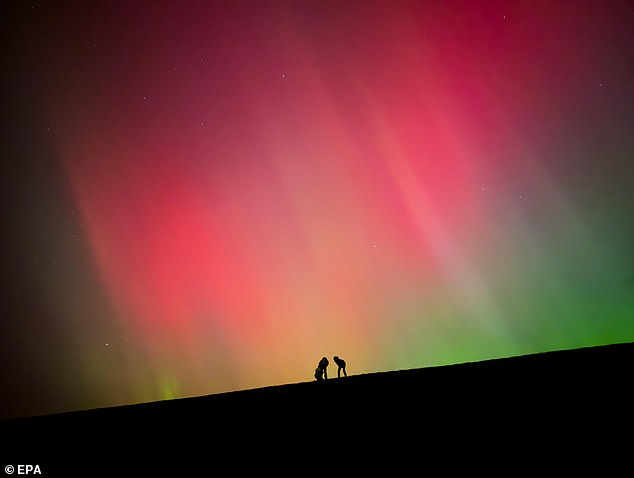Geo storm could hit TOMORROW, NASA warns
NASA predicts that a geomagnetic storm could hit Earth this week, like a blast from solar plasma rockets heading towards our planet.
The blast, known as coronal mass ejection (CME), erupted from the sun’s surface on Tuesday, and the space agency’s model warns it could trigger a geostorm that hits Earth on Friday.
The model shows this CME from Earth’s magnetosphere, the area around our planet that is dominated by a magnetic field.
This means that the chance of a geomagnetic storm is low. If one does hit, it would be a “minor” G1 storm – the lowest level of severity for these events.
G1 storms can cause minor disruptions to power grids, satellites and radio communications.
At northern latitudes, the Northern Lights – a blinding natural light phenomenon – can be visible in the night sky.
It’s already been an unprecedented year for solar activity, which has increased in recent weeks as the sun approaches solar maximum.
This peak of activity officially began on October 15 and could continue into the coming year, experts say.
A filament burst has sent a blast of solar plasma towards our planet. It is predicted to shine off Earth’s magnetic field, which could cause a small geostorm on November 1
The CME currently moving toward Earth was the result of a filament eruption at the sun’s southwestern edge that occurred around 7 a.m. ET on October 29, according to EarthSky.
Filaments are cooler regions on the Sun’s surface that can become unstable and erupt suddenly, sometimes creating CMEs.
At the time of this eruption, a large coronal hole formed in the northeastern quadrant of the Sun.
This is an area where the corona – the outermost part of the Sun’s atmosphere – is much denser and cooler than the surrounding area.
They occur when the Sun’s magnetic field is exposed to interplanetary space, and this open configuration can generate strong solar winds.
This newly formed coronal hole is currently in a geo-effective position, meaning it faces Earth and can have an effect on our planet.
The combined effect of the solar winds and the CME’s lightning strike could cause “some interesting auroral activity” on Earth on November 1, according to EarthSky.
Aurora is created when charged particles from the sun interact with Earth’s magnetic field, decorating the night sky with vibrant curtains of green, pink, red, yellow, blue and violet.

The combined effect of the solar winds and the impact of the CME could cause ‘some interesting auroral activity’ on Earth, experts say
They are most commonly seen in the aurora zone, an area within 1,500 miles of the North Pole. Normally the lights can only be seen in areas such as Scandinavia, Alaska and Iceland.
Geomagnetic storms can cause auroras to appear further south. Earlier this month, a G4 storm caused the Northern Lights to extend all the way to Florida.
It is unlikely that a G1 storm would cause the Northern Lights to extend far beyond the auroral zone. But sky watchers at northern latitudes could see some increased auroral activity Thursday evening.
And there will be more chances to see this spectacle as the sun spends the coming year at solar maximum – the period during its eleven-year cycle when solar activity is at its peak.
In 2019, scientists predicted that solar maximum would begin around July 2025. But as the sun’s activity increased over the course of 2024, it became clear that this peak would come much sooner than expected, prompting experts to revise their prediction.
In a conference call with reporters on October 15, representatives from NASA, the National Oceanic and Atmospheric Administration (NOAA) and the international Solar Cycle Prediction Panel announced that the sun had reached its maximum solar period, according to EarthSky.
The sun has already emitted 41 X-class flares this year – the strongest type.
According to spaceweather.com, that’s more than in the past nine years combined. In an average year, class X solar flares occur only about 10 times.
Solar maximum could last at least another year, so we can expect many more intense solar flares, CMEs, and geomagnetic storms to hit our planet in 2025.
